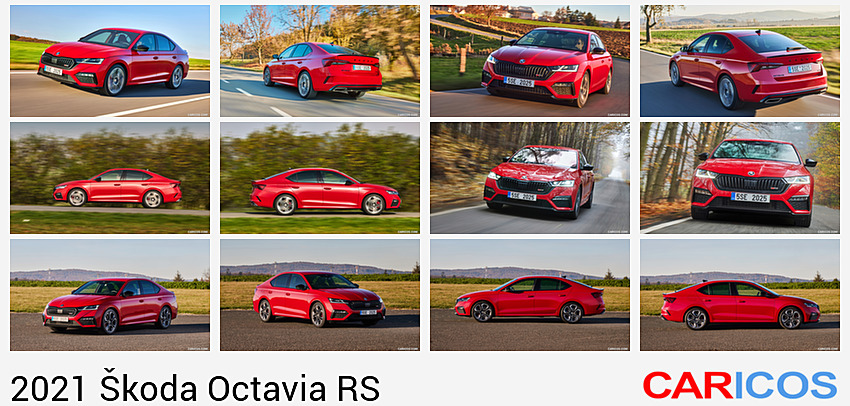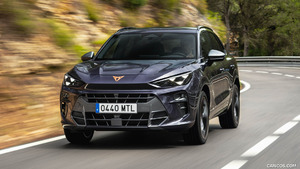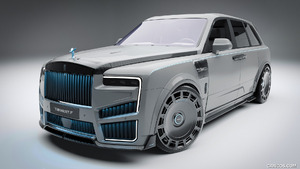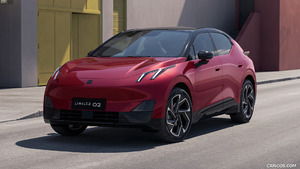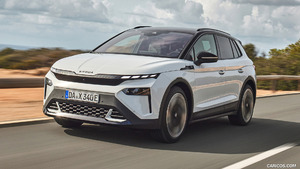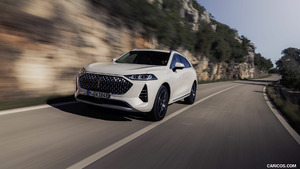2021 Octavia RS
- Dynamic and efficient: powerful EVO-generation petrol and diesel engines
- 2.0 TSI with electronic limited-slip differential and 2.0 TDI option with all-wheel drive including a new multi-plate clutch
- 15-mm-lower sports chassis as standard, with adaptive DCC option
ŠKODA’s line-up of the OCTAVIA RS now consists of a sporty trio. Following the launch of the OCTAVIA RS iV as the first RS model to feature plug in hybrid drive, the compact sports car can now be ordered with either the biggest petrol engine or the most powerful diesel in the range. As with the OCTAVIA RS iV plug in hybrid, the latest EVO-generation 2.0 TSI delivers 180 kW (245 PS). The 2.0 TDI’s power output is 147 kW (200 PS).
Engines available for the current OCTAVIA RS at a glance:
| Engine | 2.0 TSI | 2.0 TDI | |||
| Max. power output | [kW] | 180 | 147 | ||
| [PS] | 245 | 200 | |||
| Max. torque [Nm] | 370 | 400 | |||
| Transmission | 6-speed M | 7-speed DSG | 7-speed DSG | 7-speed DSG | |
| Drive | Front-wheel | Front-wheel | Front-wheel | All-wheel | |
| Top speed [km/h] | 250 | 250 | 249 (245) | 243 (238) | |
| Acceleration 0–100 km/h [s] |
6.8 | 6.7 | 7.4 | 6.8 | |
() Applies to COMBI
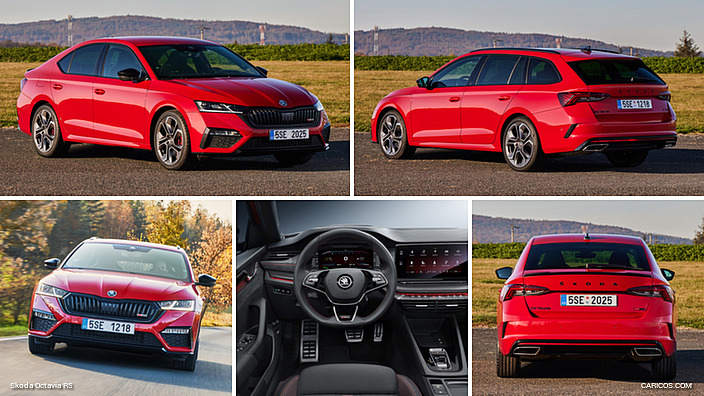 2021 Škoda Octavia RS
2021 Škoda Octavia RS
When fitted with all-wheel drive and a 2.0 TDI engine delivering 147 kW (200 PS), the OCTAVIA RS can tow a braked trailer weighing up to 2,000 kg. The front-wheel-drive ŠKODA OCTAVIA RS has a fuel capacity of 50 l, which is 5 l more than the standard OCTAVIA variant can hold. The fuel tank of the all-wheel-drive OCTAVIA RS can even hold 55 l.
Comprehensive modifications for the new EVO engines
The new 2.0 TSI engine of the ŠKODA OCTAVIA RS is based on the power unit of the previous generation’s OCTAVIA RS 245. Further development of the engine focused on maintaining its dynamic characteristics and maximum output of 180 kW (245 PS) while making it even more efficient. This was achieved, among other things, by increasing the fuel injection pressure up to 350 bar, and by using newly shaped piston crowns and a new crankshaft seal to reduce friction and, therefore, fuel consumption. Furthermore, the ŠKODA engineers modified the exhaust gas routing as well as the ignition system.
The technology of the 2.0 TDI delivering 147 kW (200 PS) is similar to that of the other EVO generation diesels, producing either 85 kW (116 PS) or 110 kW (150 PS). The 2.0 TDI features, however, an aluminium cylinder block and aluminium pistons with low-friction piston rings. In addition to that, it comes with different connecting rods, where the diameter of the journals is now 54 instead of 48 mm. The turbocharger is water-cooled for improved temperature regulation, and its compression ratio is higher.
Increased driving dynamics with a limited-slip differential, all-wheel drive to react within fractions of a second The OCTAVIA RS fitted with a TSI engine comes with an electronic limited-slip differential as standard, providing more traction and even greater driving dynamics. The sixth-generation electro hydraulic multi-plate clutch achieves a maximum lock-up torque of 1,600 Nm. The XDS+ function, which is a standard feature in other OCTAVIA models, has a locking torque of 500 Nm. The limited-slip differential works in the Normal and Sport modes, which can be accessed in Driving Mode Select.
The all-wheel-drive system – which is available as an option for the OCTAVIA RS fitted with a TDI engine – distributes power via a new, electronically controlled sixth-generation multi-plate clutch. This clutch is nearly 0.8 kg lighter than its predecessor and is more efficient thanks to the use of low-friction oil, reduced bearing preload and refined internal lubrication. The new piston pump is driven by a brushless DC electric motor which features an integrated control unit to increase the clutch’s performance as well as its lifespan. The control electronics of the all wheel drive system react to changing driving conditions within fractions of a second and boost the driving dynamics, for example when cornering fast. The system transfers part of the driving torque to the opposite wheel when the load on the inner wheel is reduced, and maintains traction. In the 2.0 TDI OCTAVIA RS models that do not feature Dynamic Chassis Control, the driver can set the characteristics of the XDS+ system to Normal or Sport using Driving Mode Select. XDS+ is an extension of the electronic differential lock (EDL) and improves traction.
Sports suspension as standard, with adaptive Dynamic Chassis Control option
The RS-typical sports chassis, which comes as standard, lowers the car by 15 mm. Adaptive Dynamic Chassis Control (DCC) is an optional extra. It constantly adjusts the damping and enables a particularly dynamic driving style in Sport mode. Using slider controls on the 10-inch central touchscreen in Driving Mode Select, it is now possible to adjust DCC parameters such as damping, steering characteristics or the operation of the DSG (direct-shift gearbox) – this is a first. The multi link rear axle distinguishes itself by providing high levels of comfort and good handling. The 2.0 TSI’s 17-inch diameter brakes ensure optimum deceleration. The 2.0 TDI has been fitted with 16-inch brakes at the front and 15-inch brakes at the rear.
New technology and assistance systems
- Making its ŠKODA OCTAVIA RS debut: DSG operation using shift-by-wire technology
- Progressive steering for increased dynamics and optimised handling as standard
- New assistance systems such as Collision Avoidance Assist and Turn Assist
The OCTAVIA RS can be ordered with any of the new technologies and innovative assistance systems the fourth-generation OCTAVIA has to offer. Shift-by-wire technology to operate the car’s DSG is making its OCTAVIA RS debut. Furthermore, the car now also boasts new systems, such as Collision Avoidance Assist and Turn Assist, to increase active safety.
The OCTAVIA RS makes use of new shift-by-wire technology to operate its DSG. The gear selector is no longer connected to the gearbox mechanically. Instead, it relays which gear has been chosen electronically. This saves space and offers new design options for the interior. The familiar DSG lever has been replaced with a new control module, housed in the centre console. This module features a small rocker switch for selecting the drive modes – R (reverse), N (neutral) and D/S (drive/sport) – as well as a button for the parking mode, P.
Progressive steering as standard
The OCTAVIA RS features progressive steering as standard. This ensures dynamic steering response and improved handling at higher speeds, while also providing optimum feel at low speeds. In addition, the OCTAVIA RS models’ steering is transmitted much more directly in contrast to the standard steering: from lock to lock, only 2.13 instead of 2.70 turns of the steering wheel are required.
New innovative and further improved driver assistance systems
The OCTAVIA RS comes with innovative and further developed assistance systems as seen in the fourth-generation OCTAVIA. By making targeted interventions in the steering, for example, the new Collision Avoidance Assist helps to drive around a pedestrian, cyclist or other vehicles, which helps to prevent an impending collision. At junctions, Turn Assist can detect oncoming traffic at an early stage when turning left, it can warn the driver or automatically stop the vehicle. The Exit Warning system, available from spring 2021, lets the occupants know if another vehicle or a cyclist is approaching from behind when a car door is open. Another new feature is the local Traffic Warning function, which automatically warns of traffic hold-ups in the car’s immediate surroundings, such as the end of a traffic jam. Side Assist warns the driver of vehicles approaching from behind or that are in the car’s blind spot. It monitors an area up to 70 m behind the vehicle and also helps to prevent accidents on motorways and dual carriageways. The system warns the driver by emitting a light on the inside of the wing mirror housings, where it is clearly visible. Side Assist is not active when towing a trailer or when a bicycle carrier is fitted to the tow bar. In urban environments, Front Assist – including Predictive Pedestrian and Cyclist Protection – warns of collisions visually, acoustically and by gently applying the brakes, slowing the car down when necessary. It detects moving and stationary vehicles in the direction of traffic, and also cyclists and people who are moving in front of the car.
Powerful design
- Radiator grille and wing mirrors in gloss black as a typical distinguishing feature
- Full LED Matrix headlights, full LED tail lights, black 18-inch alloys and red brake callipers as standard
RS models traditionally look much more dynamic than other OCTAVIAs. Exclusive black design details accentuate the car’s sporty appearance. Standard features include full LED Matrix headlights and full LED tail lights with dynamic indicators, and an animated Coming/Leaving Home function.
The ŠKODA OCTAVIA RS comes with full LED Matrix headlights and full LED tail lights, which includes dynamic indicators and an animated Coming/Leaving Home function as standard. In addition to specific front and rear aprons, numerous black design details give the car its RS-typical sporty appearance. RS logos on the radiator grille and tailgate are inspired by ŠKODA’s motorsport tradition. The striking ŠKODA grille, the front diffuser and the air curtains located above the tinted LED fog lights are all designed in gloss black. The wing mirror housings, the window frames, the COMBI’s roof rails and aeroflaps at the rear, as well as the diffuser on the rear apron, the ŠKODA lettering on the tailgate and the hatchback’s RS rear spoiler all come with a black finish. The COMBI’s roof spoiler is body-coloured. There is a choice of ten paint finishes, including the standard colour Mamba Green (to follow in the first half of 2021).
18- or 19-inch alloy wheels and larger dimensions
RS models feature black 18-inch alloy wheels as standard; the brake callipers boast an eye catching RS-typical red finish. 19-inch alloys are available as an option.
Dimensions of the current OCTAVIA RS at a glance:
| Dimensions | OCTAVIA RS | OCTAVIA COMBI RS |
| Length [mm] | 4,702 | 4,702 |
| Width [mm] | 1,829 | 1,829 |
| Height [mm] | 1,457 | 1,455 |
| Wheelbase [mm] | 2,681 | 2,681 |
| Kneeroom [mm] | 78 | 78 |
| Boot capacity [l] 600 640 |

